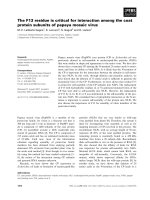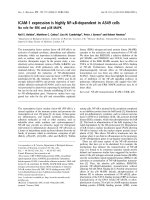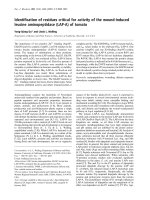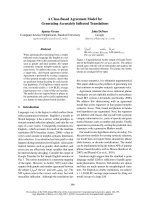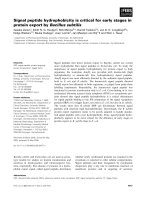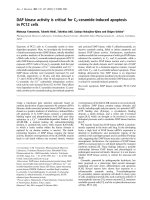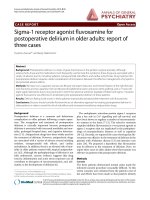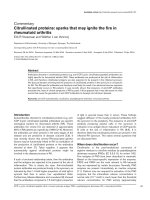Báo cáo Y học: DAP kinase activity is critical for C2-ceramide-induced apoptosis in PC12 cells ppt
Bạn đang xem bản rút gọn của tài liệu. Xem và tải ngay bản đầy đủ của tài liệu tại đây (385.92 KB, 9 trang )
DAP kinase activity is critical for C
2
-ceramide-induced apoptosis
in PC12 cells
Mutsuya Yamamoto, Takeshi Hioki, Takehisa Ishii, Sadayo Nakajima-Iijima and Shigeo Uchino*
Pharmaceuticals Discovery Laboratory, Yokohama Research Center, Mitsubishi-Tokyo Pharmaceuticals Inc., Aoba-ku, Yokohama,
Japan
Exposure o f PC12 cells to C
2
-ceramide results in dose-
dependent apoptosis. Here, we investigate the involvement
of death-associated protein (DAP) kinase, initially identi®ed
as a positive mediator of the interferon-c-induced apoptosis
of HeLa cells, i n t he C
2
-ceramide-induced apoptosis of PC12
cells. DAP kinase is endogenously expressed i n these cells. On
exposure of PC12 cells to 30 l
M
C
2
-ceramide, both the total
(assayed in the presence of Ca
2+
/calmodulin) and Ca
2+
/
calmodulin-independent (assayed in the presence of EGTA)
DAP kinase activities were transiently increased 5.0- and
12.2-fold, respectively, at 10 min, and t hen decreased to
1.7- and 3.4-fold at 90 min. After 10 min exposure to 30 l
M
C
2
-ceramide, the C a
2+
/calmodulin independent activity/
total activity ratio increased f rom 0.22 to 0.60. These eects
were dependent on the C
2
-ceramide concentration. C
8
-cera-
mide, another active ceramide analog, also induced apoptosis
and activated DAP kinase, while C
2
-dihydroceramide, an
inactive ceramide analog, failed to induce apoptosis and
increase DAP kinase activity. Furthermore, transfection
studies revealed that overexpression of wild-type DAP kinase
enhanced the sensitivity to C
2
-andC
8
-ceramide, while a
catalytically inactive DAP kinase mutant and a construct
containing the death domain and C-terminal tail of DAP
kinase, which act in a dominant-n egative manner, rescued
cells from C
2
-, and C
8
-ceramide-induced apoptosis. These
®ndings demonstrate that DAP kinase is an important
component of the apoptotic machinery involved in ceramide-
induced apoptosis, and that the intrinsic DAP kinase activity
is critical for ceramide-induced apoptosis.
Keywords: apoptosis; DAP kinase; ceramide; PC12; CaM
kinase.
Using a functional gene selection approach based on
random inactivation of gene expression by antisense cDNA
libraries, death-associated protein kinase (DAP kinase) was
cloned as a positive mediator of interferon-c-ind uced HeLa
cell apoptosis [1±3]. DAP k inase c ontains a calmodulin-
binding region and phosphorylates both itself and other
substrates in a C a
2+
/calmodulin-dependent fashion [1,4].
DCaM-DK, a mutant lacking the c almodulin-binding
domain, is constitutively active, while mutant K42A-DK,
in which a lysine residue within the kinase domain is
replaced by an alanine residue, is inactive. The death-
promoting function of DAP kinase requires t he kinase
activity; therefore overexpression of the DCaM-DK mutant
leads to cell death without any external stimuli, whereas
overexpression of the K42A-DK mutant is not cytotoxic [4].
In addition, DAP kinase contains unique domains and
motifs, including eight ankyrin repeats, two potential ATP/
GTP binding sites (P-loops), a cytoskeleton binding
domain, a d eath domain, and a serine rich C-terminal
region [4,5], which are thought to be involved in various
biological processes and to modulate DAP kinase function
[4,6,7].
We recently found that DAP kinase mRNA is predom-
inantly expressed in the brain and lung. In the developing
brain, a high level of DAP kinase m RNA expression is
detected in proliferative and postmitotic regions of the
cerebral cortex and hippocampus and in cerebellar Purkinje
cells, suggesting that DAP kinase may p lay a pivotal role in
neurogenesis; furthermore, the expression of DAP kinase
mRNA is increased prior to cell death induced by transient
forebrain ischemia [8]. These ®ndings indicate a possible
relationship between DAP kinase and physiological or
pathological neuronal cell death. However, it is not known
whether DAP kinase activity is critical for neuronal cell
death.
Ceramide, generated by sphingomyelin hydrolysis, has
been proposed as a pleiotropic lipid second messenger
regulating cell cycle arrest, d ifferentiation and apoptosis
[9,10]. Several reports have shown that exposure to a
cell-permeable ceramide analog, N-acetylsphingosine
(C
2
-ceramide), induces apoptotic cell death in many types
of cells, including neuronal cells, such as primary cultures of
mesencephalic neurons [11], sensory neurons [12], immature
cerebellar granule cells [13], and the rat pheochromocytoma
cell line, PC12 [14].
Correspondence to M. Yamamoto, Pharmaceuticals Discovery
Laboratory, Yokohama Research Center, Mitsubishi-Tokyo
Pharmaceuticals Inc., 1000 Kamoshida, Aoba-ku, Yokohama
227-8502, Japan. Fax: + 81 45 963 3992, Tel.: + 81 45 963 4340,
E-mail: mut
Abbreviations: DAP kinase, death-associated protein kinase; MLC
kinase, myosin light chain protein kinase; CaM kinase, Ca
2+
/cal-
modulin-dependent protein kinase; ZIP kinase, zipper-interacting
protein kinase; DMEM, Dulbecco's modi®ed Eagle's medium;
C
2
-ceramide, N-Acetylsphingosine; C
8
-ceramide, N-octanoylsp-
hingosine C
2
-dihydroceramide, N-acetylsphinganine; EGFP,
enhanced green ¯uorescent protein.
*Present address: Department of Neurochemistry, National Institute
of Neuroscience, Kodaira, Tokyo, Japan.
(Received 2 J uly 2001, accepted 24 October 2001)
Eur. J. Biochem. 269, 139±147 (2002) Ó FEBS 2002
In this study, we employed P C12 cells, w hic h are
extensively used as a model to study mechanisms
regulating neu ronal s urvival and a poptotic cell death
[15], to study the role of DAP kinase in ceramide-induced
apoptosis. DAP kinase was found to be activated in the
early response to ceramide exposure, and the activity
depended on the ceramide concentration. The proportion
of Ca
2+
/calmodulin-independent activity was also
increased during this process. Furthermore, overexpression
of wild-type DAP kinase made cells more sensitive to
ceramide. In contrast, overexpression of the K42A-DK
mutant or of DD-DK, a construct containing the death
domain a nd the C-terminal tail, which acts as another
kind of dominant negative mutant [6], protected cells from
ceramide-induced apoptosis. This is the ®rst study to
quantitatively measure DAP kinase activity and to show
that DAP kinase is an important component of the
apoptotic machinery involved in ceramide-induced
apoptosis.
EXPERIMENTAL PROCEDURES
Drugs and reagents
N-Acetylsphingosine (C
2
-ceramide) (Sigma Chemical Co.,
St Louis, MO), N-octanoylsphingosine (C
8
-ceramide)
(Calbiochem-Novabiochem Corp., San Diego, CA) and
N-acetylsphingan ine (C
2
-dihydroceramide) (ICN Pharma-
ceuticals, Inc., Costa Mesa, CA) were dissolved in ethanol.
The ®nal ethanol concentration in the culture medium in
all experiments was less than 0.25%. [c-
32
P]ATP
(6000 Ciámmol
)1
) and ATP were purchased from
Amersham Pharmacia Biotech (Little Chalfont Bucking-
hamshire, UK) and AMRESCO Inc. (Solon, OH, USA),
respectiv ely.
Cell culture
PC12 cells were maintained at 37 °C on collagen-coated
dishes (Iwaki Glass Co., Ltd, Tokyo, Japan) in normal
growth medium composed of Dulbecco's modi®ed Eagle's
medium (DMEM) (Life Technologies, Inc., Grand Island,
NY, U SA) supplemented with 5% fetal bovine serum (Life
Technologies, Inc.), 5% horse serum (Life Technologies,
Inc.), 15 m
M
Hepes (pH 7.4; Life Technologies, Inc.), and
50 lgámL
)1
of gentamycin (Sigma) in a humidi®ed atmo-
sphere containing 5% CO
2
.
DNA fragmentation assay
PC12 ce lls were collected by centrifugation and lysed at
50 °C for 2 h in 200 m
M
Tris/HCl (pH 8.0), 100 m
M
EDTA,1%SDS,and0.1mgámL
)1
of proteinase K
(Nacalai tesque, Inc., Kyoto, Japan). Potassium acetate
(5.0
M
) was then added to a ®nal concentration of 1.0
M
and
the lysate centrifuged at 15 000 g for 15 min at 4 °C. The
DNA in the supernatant was extracted with an equal
volume of phenol/chloroform, precipitated with ethanol,
and s uspended i n 1 0 m
M
Tris/HCl (pH 8.0) and 1 m
M
EDTA containing 20 lgámL
)1
of RNaseA (Nacalai tesque,
Inc.). The DNA (2 lg) was then electrophoresed on a 2%
agarose gel, and visualized under UV light after staining
with ethidium bromide.
Kinase assay
PC12 cells were collected by centrifugation, washed twice
with ice-cold NaCl/P
i
, then lysed in lysis buffer [50 m
M
Tris/HCl (pH 7.5), 70 m
M
NaCl, 1% Triton X-100, 5 m
M
EDTA, 5 m
M
EGTA, 2 m
M
phenylmethylsulfonyl ¯ uo-
ride (Sigma), 1 lgámL
)1
aprotinin (Roche Diagnostics
GmbH, Mannheim, Germany), 1 lgámL
)1
leupeptin
(Roche Diagnostics GmbH), 100 n
M
okadaic acid
(Calbiochem-Novabiochem Corp.), 50 m
M
NaF (Nacalai
tesque, Inc.), 10 m
M
Na
3
VO
4
,30l
M
mycalolide B (Wako
Pure Chemical Industries, Ltd, Osaka, Japan)] [16]. After
insoluble material was removed by centrifugation
(15 000 g for 5 min a t 4 °C), the lysates were immuno-
precipitated with monoclonal anti-(DAP kinase) Ig
(Sigma) absorbed on p rotein G±Sepharose 4FF (Amer-
sham Pharmacia Biotech). After three washes with kinase
assay buffer [50 m
M
Tris/HCl (p H 7.5), 8 m
M
MgCl
2
,
0.01% BSA, 100 n
M
okadaic acid, 0.5 m
M
dithiothreitol],
the beads were incubated for 10 min at 30 °Cinkinase
assay buffer containing 100 l
M
skeletal muscle myosin
light chain kinase (MLC k inase) substrate peptide
(AKRPQRATSNVFS) ( ICN Pharmaceuticals, I nc.),
200 l
M
[c-
32
P]ATP (1 Ciámmol
)1
) and either 0.5 m
M
CaCl
2
and 1 l
M
bovine calmodulin (Sigma) (total activity)
or 1 m
M
EGTA (Ca
2+
/calmodulin ind ependent activity)
[17]. Incorporation of
32
P into MLC kinase substrate
peptide w as measured essentially as described by DeR-
emer et al. [18]. After incubation, aliquots of reaction
mixture were spotted onto P81 phosphocellulose paper
(Whatman Inc., Clifton, NJ, USA), which was then
washed three times with 75 m
M
H
3
PO
4
, rinsed with
ethanol, dried, and subjected to liquid scintillation count-
ing. Kinase activity was normalized to the amount of
DAP kinase in the immunoprecipitants, determined by
immunoblotting using monoclonal anti-(DAP kinase) Ig
(1 : 250 dilution; Transduction Laboratories, Lexington,
KY, USA) as primary antibody and horseradish peroxi-
dase-conjugated goat anti-(mouse IgG) Ig ( 1 : 1000 dilu-
tion; Santa Cruz B iotechnology, Inc., Santa Cruz, CA,
USA) as secondary antibody with quanti®cation on an
Imaging Scanner (ES-8000; Epson, Tokyo, Japan) with
NIH IMAGE
1.61 software.
DNA transfection
PC12 cells were plated at a density of 2.6 ´ 10
4
cells per
cm
2
in normal growth medium in collagen-coated culture
dishes and incubated a t 37 °C for 24 h. The cells were
cotransfected with 0.04 lgácm
)2
of pQBI25 containing
enhanced green ¯uorescent protein (EGFP) cDNA
(Quantum Biotechnologies Inc., Montreal, Canada) and
with 0.36 lgácm
)2
of mock expression plasmid (pcDNA3;
Invitrogen Corp., Carlsbad, CA, USA) or the DAP
kinase expression plasmids, pDK-wt, pDK-DCaM,
pDK-K42A, or pDK-DD, carrying, respectively, cDNA
coding for wild-type DAP kinase, th e DCaM-DAP
kinase mutant, the K42A-DAP kinase mutant, or the
DD-DAP kinase mutant (aspartic acid 1299 to arginine
1430), all with an hemagglutinin (HA)-tag, in pcDNA3
[5,6] using 2 lLácm
)2
of SuperFect reagent (QIAGEN
Inc., Valencia, CA, USA) according to the manufacturer's
instructions.
140 M. Yamamoto et al. (Eur. J. Biochem. 269) Ó FEBS 2002
Immunoblotting
Forty-eight hours after transfection, the PC12 cells were
washed with ice-cold NaCl/P
i
, harvested, and lysed with a
buffer consisting of 50 m
M
Tris/HCl (pH 7.5), 1 50 m
M
NaCl, 1% Triton X-100, 5 m
M
EDTA, 2 m
M
phen-
ylmethanesulfonyl ¯uoride, 1 lgámL
)1
aprotinin,
1 lgámL
)1
leupeptin, and 30 l
M
mycalolide B. After the
insoluble material was removed by centrifugation (15 000 g
for 5 min at 4 °C), the protein concentration of the
supernatant was determined using a protein assay kit
(Bio-Rad Laboratories, Hercules, C A, USA). Equal
amounts of protein (2 lg) were then separated by electro-
phoresis on 10% or 15% SDS/polyacrylamide gels, and
electrophoretically transferred onto poly(vinylidene di¯uo-
ride) (PVDF) membranes (Millipore C orp., Bedford, MA,
USA). To detect the exogenous DAP kinase or actin used as
the internal control, the membranes were blocked by
incubation for 30 min at ro om temperature with 2% dried
skimmed milk in NaCl/P
i
containing 0.1% Tween-20,
(NaCl/P
i
/Tween) then incubated for 1.5 h at room temper-
ature with rat monoclonal anti-HA Ig (1 : 5000 dilution;
Roche Diagnostics GmbH) or polyclonal anti-actin Ig
(1 : 5000 dilution; Sigma Chemical C o.). After washing with
NaCl/P
i
/Tween, the blots were incubated with horseradish
peroxidase-conjugated goat anti-(rat IgG) Ig ( 1 : 1000
dilution; Santa Cruz Biotechnology, Inc.) or horseradish
peroxidase-conjugated goat anti-(rabbit IgG) Ig (1 : 5000
dilution; Santa Cruz Biotechnology, Inc.) and the reactive
bands visualized using a n enhanced chemiluminescence
system (ECL plus; Amersham Pharmacia Biotech.) as
indicated in the manufacture's protocol.
RESULTS
Apoptosis induced by ceramide
Recent reports indicate that exposure to high concentrations
(10±50 l
M
) of exogenous C
2
-ceramide results in apoptosis
of neuronal cells and that the ap optotic effect depends on
the concentration o f C
2
-ceramide and the cell plating density
[11±14]. We therefore initially determined the optimal
experimental conditions leading to apoptosis in PC12 cells.
PC12 cells were plated at a density of 5.0 ´ 10
4
cells per cm
2
in normal growth medium, then, after 2 days, the culture
medium was changed to DMEM containing 1% horse
serum, 50 lgámL
)1
gentamycin (serum reduced medium),
and 0, 3, 10, 20, 30, or 50 l
M
C
2
-ceramide. After incubation
at 37 °C f or 12 h, DNA was extracted and chromatin
fragmentation examined by electrophoresis. No DNA
ladder was seen in PC12 cells treated with 0, 3, 10, or
20 l
M
C
2
-ceramide, but a typical DNA ladder was detected
in t he p re sence of 30 o r 50 l
M
C
2
-ceramide (Fig. 1A),
showing that concentrations of C
2
-ceramide greater than
30 l
M
induced apoptosis in PC12 cells under these condi-
tions. Similar results were obtained using C
8
-ceramide, an
active ceramide analog with a longer 8-carbon fatty acid
chain (Fig. 1B). In contrast, an inactive ceramide analog,
C
2
-dihydroceramide, which lacks the C4±5 trans double
bond in th e sphingolipid backbone that is required for the
biological effects of ceramide [19], failed to induce apoptosis
(Fig. 1C). Typical apoptotic molphological changes, such as
shrinkage, rounding up, and loss of adherence, and staining
of the nuclei by propidium iodide, were seen in PC12 cells
exposed to 30 l
M
C
2
- ( Fig. 1D) and C
8
-ceramide (data not
shown), but not in those e xposed to 30 l
M
C
2
-dihydrocera -
mide (Fig. 1E).
Ceramide-induced apoptosis is accompanied by DAP
kinase activation
DAP kinase, a Ca
2+
/calmodulin-regulated serine/threonine
kinase, is a positive mediator of apoptosis [1±3]. As Western
blotting showed that DAP kinase was endogenously
expressed in PC12 cells (Fig. 2 , lane 1), we examined
whether the ceramide-induced apoptosis in PC12 cells was
accompanied by DAP kinase activation.
The physiological substrate of D AP kinase has not been
identi®ed. In a previous report [4], puri®ed myosin light
chain was used as a substrate, as the catalytic domain of
DAP kinase is highly h omologous to that of MLC kinase.
Zipper-interacting protein kinase (ZIP kinase), with a
sequence 81% identical to that of the kinase domain of
DAP kinase [20±22], a lso phosphorylates the regulatory
light chain of myosin II the phosphorylation sites being
threonine 18 and serine 1 9 [22]. In this study, the synthetic
peptide, skeletal myosin light chain kinase substrate peptide,
which contains the regulatory light chain of myosin II site
phosphorylated by ZIP kinase, was used as substrate t o
measure DAP kinase activity.
DAP kinase activity was measured 0, 3, 10, 3 0, and
90 min a fter changing to serum-reduced medium containing
30 l
M
C
2
-ceramide, C
8
-ceramide, or C
2
-dihydroceramide in
the presence (total activity) or in the absence (Ca
2+
/
calmodulin independent activity) of Ca
2+
and calmodulin
[17]. When the cells were exposed to C
2
-andC
8
-ceramide,
the Ca
2+
/calmodulin-independent DAP kinase activity was
increased 3.6- and 2.9-fold, respectively, at 3 min, showed a
maximal increase of 12.2- and 11.6-fold at 10 min, then
reduced to 5.6- and 6.4-fold at 30 min; a 3.4- and 3.6-fold
increase was still apparent after 90 min (Fig. 3A). As shown
in Fig. 3B, in the presence of C
2
-andC
8
-ceramide, the total
DAP kinase activities a lso increased 2.1- and 1.8-fold at
3 min, showed a maximal increase of 5.0- and 4.8- fold
at 10 min, then gradually decreased to 1.7- and 1.8-fold at
90 min The Ca
2+
/calmodulin independent activity/total
activity ratio is shown in Fig. 3C. This ratio, which was 0.22
in the absence of ceramide (0 min), increased to 0.60 and
0.64 after 30 min exposure to C
2
-andC
8
-ceramide,
respectively, then declined gradually. In contrast, 30 l
M
C
2
-dihydroceramide caused no increase in either total or
Ca
2+
/calmodulin-independent DAP kinase activity, and no
change in the ratio (Fig. 3A±C).
We next determined whether the increase in DAP k inase
activity was dependent on the ceramide concentration by
exposing P C12 cells to 0, 10, 20, 30, or 50 l
M
C
2
-ceramide,
C
8
-ceramide, or C
2
-dihydroceramide f or 10 min. As shown
in Fig. 4A, Ca
2+
/calmodulin-independent DAP kinase
activity was slightly stimulated by 1.4- and 1.3-fold by
exposure to 10 l
M
C
2
-andC
8
-ceramide, and greater activity
was seen with increasing concentrations of these reagents,
theincreaseat50l
M
C
2
-andC
8
-ceramide being 12.2- and
11.6-fold, respectively. Total DAP kinase activity also increa-
sed with increasing concentration of ceramide, the increase
at 50 l
M
C
2
-andC
8
-ceramide b eing 6.5- and 6.1-fold,
respectively (Fig. 4B). The Ca
2+
/calmodulin-independent
Ó FEBS 2002 DAP kinase as ceramide-induced apoptotic component (Eur. J. Biochem. 269) 141
activity/total activity ratio a lso increased with ceramide
concentration, reaching a p lateau of 0.54 and 0.55 at 30 l
M
C
2
-andC
8
-ceramide, respectively (Fig. 4C). In contrast,
C
2
-dihydroceramide was ineffective in activating DAP
kinase and in changing the Ca
2+
/calmodulin-independent
activity/total activity ratio at any c oncentration t ested
(Fig. 4A±C).
Approximately equal amounts of DAP kinase were
immunoprecipitated irrespective of the test exposure time or
the concentration of C
2
-ceramide, C
8
-ceramide, or
C
2
-dihydroceramide. Figure 2 shows the results of a typical
immunoblotting experiment after 10 min exposure to 30 l
M
C
2
-ceramide, C
8
-ceramide, or C
2
-dihydroceramide.
Protection from ceramide-induced apoptosis by DAP
kinase inhibition
To determine whe ther DAP kinase activity was critical for
C2- and C
8
-ceramide-induced apoptosis, we investigated the
viability of PC12 cells overexpressing the wild-type DAP
kinase, t he DCaM-DAP kinase m utant (a c onstitutively
active kinase mutant), the K 42A-DAP kinase mutant (a
catalytically inactive mutant displaying dominant negative
features), or a construct encompassing the death domain
and the serine-rich C-terminal tail (another kind of
Fig. 1. C
2
-ceramide and C
8
-ceramide induce apoptosis in PC12 cells. PC12 cells were cultured in serum-reduced medium containing 0 l
M
(lane 1),
3 l
M
(lane 2), 10 l
M
(lane 3), 20 l
M
(lane 4) , 30 l
M
(lane 5 ), or 50 l
M
(lane 6 ) C
2
-ceramide (A), C
8
-ceramide (B ), or C
2
-dihydroceramide (C). After
12 h , 2 lg of DNA was prepared and examined for the presence of a DNA ladder as described in Experimental procedures. The size markers are
indicated on the left. Morp hologic al appearance of PC12 c ells exposed to 30 l
M
C
2
-ceramide (D) or 30 l
M
C
2
-dihydroceramide (E). PC12 cells were
stainedwith3 lgámL
)1
propidium iodide (PI) (D ojindo, Kumamoto, Japan) and o bserved under a phasecontrast (BF) or a ¯uorescence microscope
(PI) (Carl Zeiss, Esslingen, Germany).
Fig. 2. Immunoblot analysis of DAP kinase in immunoprecipitates.
Monoclonal anti-(DAP kinase) Ig (Sigma) was used to immunopre-
cipitate endogenous DAP kinase from extracts of P C12 cells for
10 m in in the absence of ceramide (lane 1) or in the presence of 30 l
M
C
2
-ceramide ( lane 2), 30 l
M
C
8
-ceramide ( lane 3), or 30 l
M
C
2
-dihy-
droceramide ( lane 4). The immunoprecipitates were analyzed b y
immunoblotting using another monoclonal anti-(DAP kinase) Ig
(Transduction Laboratories).
142 M. Yamamoto et al. (Eur. J. Biochem. 269) Ó FEBS 2002
Fig. 3. Time course of ceramide-induced DAP
kinase activation. PC1 2 cells were exposed to
30 l
M
C
2
-ceramide, C
8
-ceramide, or C
2
-dihy-
droceramide for 0, 3, 10, 30, or 90 min, then
the cells wer e solubilized in lysis b uer, and
DAP kinase immunoprecipitated with mono-
clonal anti-(DAP kinase) Ig. The kinase
reaction was performed in the absence (Ca
2+
/
calmodulin-independent activity, A) o r pres-
ence (total activity, B) of Ca
2+
and calmodu-
lin. The relative DAP k inase activity was
determined by comparison with the value
measured in the absence of ceramide (0 min).
The data are presented as the mean SD of
four measurements. (C) Shows the ratio
obtained by dividing the actual value for
Ca
2+
/calmodulin-independent activity by that
for the total activity.
Fig. 4. Concentration dependency of DAP
kinase activation by ceramide. PC12 cells were
exposed for 10 min to 0, 10, 20, 3 0, or 50 l
M
C
2
-ceramide, C
8
-ceramide, or C
2
-dihydro-
ceramide, then solubilized in lysis buer, and
DAP kinase immunoprecipitated with mono-
clonal anti-(DAP kinase) Ig. The kinase
reaction was performed in the absence (Ca
2+
/
calmodulin-independent activity, A) o r pres-
ence (total activity, B) of Ca
2+
and calmodu-
lin. The relative activity of DAP kinase w as
determined by comparison with that in the
absence of ceramide (0 l
M
). The data a re
the mean SD of four measurements.
(C) Shows the ratio obtained by dividing the
actual value for Ca
2+
/calmodulin-indepen-
dent activity by that for t he total a ctivity.
Ó FEBS 2002 DAP kinase as ceramide-induced apoptotic component (Eur. J. Biochem. 269) 143
dominant negative mutant) (Fig. 5A). PC12 cells were
cotransfected with pcDNA3, pDK-wt, pDK-DCaM, pDK-
K42A, or pDK-DD, and pQBI25 containing EGFP cDNA
as a marker to visualize the transfected cells. The transfec-
tion ef®ciency was determined by counting the number of
EGFP-positive cells at 8 h after DNA transfection and was
veri®ed to be about 20%, similar in all experiments. After
48 h, ectopic expression of the wild-type and mutant DAP
kinase proteins was con®rmed by immunoblotting using
monoclonal anti-HA Ig (Fig. 5B). A s expected, the speci®c
band of DAP kinase with an apparent molecular mass of
165 KDa was seen in PC12-wtDK and PC12-K42A-DK
cells, a slightly lower molecular mass band (160 KDa) was
detected in PC12-DCaM-DK cells, a nd a band at 16 KDa
was s een in PC12-DD-DK cells. The band intensity in
PC12-DCaM-DK cells was weaker than that in the PC12-
wtDK and PC12-K42A-DK cells, suggesting that overex-
pression of the DCaM-DAP kinase mutant resulted in some
growth disadvantage for PC12 cells. No band was seen in
PC12 cells transfected w ith pcDNA3 vector alone .
Ectopic expression of DAP kinase in PC12 cells (PC12-
wtDK) did not cause cell death in the absence of stimuli.
This is in agreement with the results o f previous studies
using COS cells [1,4], murine Lewis (3LL) and CMT64 lung
carcinoma cells [23], but con¯ icts with results in HeLa cells
and SV80 human ®broblasts [1,4]. The transfected PC12
cells were cultured for 48 h, then e xposed for 2 4 h to 30 l
M
C
2
-ceramide, C
8
-ceramide or C
2
-dihydroceramide. T o
determine cell viability, we counted the number o f mor-
phologically intact EGFP-positive cells under a ¯uorescent
microscope (Fig. 6). The viability of PC12-wtDK cells was
markedly decreased by exposure to 30 l
M
C
2
-and
C
8
-ceramide, b ut not by exposure t o 30 l
M
C
2
-dihydro-
ceramide. Furthermore, PC12-wtDK cells were more
sensitive to C
2
-andC
8
-ceramide than PC12 cells transfected
with p cDNA3 mock vector. For PC12-DCaM-DK cells,
viable cell numbers were much lower even i n the absence of
ceramide or in the presence of 30 l
M
C
2
-dihydroceramide.
In contrast, PC12-K42A-DK and PC12-DD-DK cells were
signi®cantly resistant to 30 l
M
C
2
-andC
8
-ceramide-
Control wt-DK ∆CaM-DK K42A-DK
anti-HA
DD-DK
anti-actin
B
∆CaM-DK
K42A-DK
DD-DK
wt-DK
A
HA-tag
Kinase domain Ankyrin repeats Death domain
CaM binding Cytoskelton binding
0 200 400 600 800 1000 1200 1400
Fig. 5. Expression of wild-type and mutated DAP kinase p roteins i n transiently transfected P C12 c ells. (A) Schematic presentation of the human
DAP kinase mutant proteins u se d in these ex pe rimen ts. The DCaM-DK mutant lack s 47 a mino acid residues (pro line 277 to leucine 323) containing
the calmodulin-binding domain. In the K42A-DK mutant, a lysine residue at position 42 in t he kinase domain (asterisk) is replaced by an a lanine.
The D D-DK construct contains the death domain a nd the serine-rich tail (aspartic acid 1299 to arginine 1430). All expressed proteins have an
HA-tag sequence (cross) at th e N -terminal. ( B) PC12 cells were transfected with pcDNA3 (control), pDK-wt (wt-DK) , pDK- DCaM (DCaM-DK),
pDK-K42A (K42A-DK), or pDK-DD (D D-DK) and proteins we re prepared as described in Experimental procedures. Approximately 2 lgof
each preparation was separated on a 10% SDS-polyacrylamide gel for control, wt-DK, DCaM-DK and K42A-DK, and on a 15% SDS/
polyacrylamide gel for DD-DK and actin. After electrophoretic transfer onto poly( vinylidene di¯uoride) membrane, the blot was reacted with anti-
HA Ig to detect ectopic expression of DAP k inase and th e mutants (up per panel) and with a nti-actin Ig ( lower panel) t o quantitate th e loaded
protein a mount s. In the left panel, the arrow on the right indicates the w t-DK and K42A-DK bands at 165 K Da and the arrowhead indicates the
DCaM-DK band with a slightly lower molecular mass (160 KDa). I n the righ t panel, the arro w indicates the DD-DK band at 16 KDa.
144 M. Yamamoto et al. (Eur. J. Biochem. 269) Ó FEBS 2002
induced apoptosis. These ®ndings clearly demonstrate that
DAP k inase activity is critical f or C
2
-andC
8
-ceramide-
induced apoptosis in PC12 cells.
DISCUSSION
DAP kinase is a Ca
2+
/calmodulin-regulated serine/threo-
nine kinase that participates in apoptosis induced by a
variety of signals [1,6]. We recently showed that the
expression of DAP kinase mRNA in brain is increased
prior to cell death induced by transient forebrain ischemia
[8]. These ®ndings indicate a possible relationship between
DAP kinase and neuronal cell death, including apoptosis
and necrosis. However, it is not known whether the k inase
activity is involved in apoptosis. In the present study, we
employed PC12 cells, extensively used as a model to study
mechanisms regulating apoptosis [15], to investigate the role
of DAP kinase activity in ceramide-induced apoptosis.
The results of the DNA fragmentation assay and
morphological observation of cells using propidium iodide
showed that, in agreement with a previous report [14], C
2
-,
and C
8
-ceramide both induced apoptosis in PC12 cells.
Although DAP kinase was expressed in PC12 cells, both the
total a nd Ca
2+
/calmodulin-independent DAP kinase activ-
ities were very low under normal growth conditions.
However, in the presence of C
2
-orC
8
-ceramide, the total
and Ca
2+
/calmodulin-independent activities were increased
in a c oncentration-dependent manner b y a maximum of
13-fold and ®vefold, r espectively, after 10 min of exposure,
then gradually decreased, although s till showing a twofold
to fourfold increase after 90 min o f exposure. In addition,
the Ca
2+
/calmodulin-independent activity/total activity
ratio also increased from 0.2 to 0.6 following exposure to
C
2
-orC
8
-ceramide, these increases being maintained at 0.4±
0.5 even after 90 min. Similar results have been obtained
with Ca
2+
/calmodulin-dependent protein kinase IV ( CaM
kinase IV), one of the member of the CaM kinase family
[24]. It is thought that CaM kinase IV requires phospho-
rylation by a CaM kinase kinase, which is Ca
2+
/calmod-
ulin-responsive, for full activation. A previous study using
Jurkat T lymphocytes showed that both the total and Ca
2+
/
calmodulin-independent CaM kinase IV activities were
increased by treatment with ant i-CD3 Ig, which triggers an
intracellular Ca
2+
increase, a nd that the Ca
2+
/calmodulin-
independent activity/total activity ratio was increased. These
results suggest that CaM kinase IV is activated through a
CaM kinase kinase cascade triggered by a n increase in
intracellular Ca
2+
levels, and as CaM kinase IV activated
by CaM kinase k inase has signi®cant Ca
2+
/calmodulin-
independent activity, it has the potential for prolonged
activation. It is tempting to speculate that ceramide-
activated DAP kinase, which shows signi®cant Ca
2+
/
calmodulin-independent activity, has the potential for
prolonged activation and subsequently results in apoptosis
in PC12 cells. This idea was supported by the results of
transfection s tudies showing that the K42A-DAP kinase
mutant failed to induce apoptosis in the presence of
ceramide, that the DCaM-DAP kinase mutant induced
apoptosis even in the absence of ceramide, and that PC12
cells overexpressing DAP kinase showed higher sensitivity
to ceramide than untransfected PC12 cells. Thus, the
intrinsic kinase activity of DAP kinase is critical for
apoptosis.
The mechanism of DAP kinase activation has not been
clear. DAP kinase undergoes phosphorylation and the
intrinsic activity is stimulated by Ca
2+
/calmodulin [1,4].
However, in accor dance with a p revious observation in
C
6
-ceramide-treated U937 cells [25], permeant-ceramide-
treated Jurkat T cells [26] and foreskin ®broblasts [27], we
could not detect any C
2
-orC
8
-ceramide-induced increase in
intracellular Ca
2+
level using calcium ¯uorometry and a
fura-2 ¯uorescent probe (data not shown). T his is also
consistent with the result that c eramide-treated PC12 cells
had signi®cant Ca
2+
/calmodulin-independent DAP kinase
Fig. 6. Viability of PC12 cells expressing wild-type and DAP kinase mutants after ceramide exposure. Re sistance to ceramide-induced apoptosis was
quanti®ed by c ounting the number of morphologically intact EGFP-positive cells u nder a ¯uorescence m icroscop e. PC12 cells were transfected with
expression plasmids. The transfection eciency, about 20%, is con®rmed to be similar i n all experime nts by cou nting the nu mber of EGF P-positive
cells at 8 h after DNA transfection. Then, after 48 h, cells were incubated for 24 h in the absenc e of ceramide (white column) or in the prese nce of
30 l
M
C
2
-ceramide (black column), C
8
-ceramide (grey column), or C
2
-dihydroceramide (striped column) and the number of the surviving EGFP-
positive cells were counted. The percentage of cell viability is caluculated b y dividing t he number of EGFP-positive cells in each experimental
conditions by the number of EGFP-positive cells transfected with pcDNA3 alone in t he absence of ceramide. The data a re the mean SD of seven
randomly selected ®elds in t hree independent experiments.
Ó FEBS 2002 DAP kinase as ceramide-induced apoptotic component (Eur. J. Biochem. 269) 145
activity. Thus, one possible mechanism of DAP kinase
activation is a change in phosphorylation state (i.e. phos-
phorylation and dephosphorylation). In the ceramide-
induced apoptosis pathway, other molecules t hat are
Ca
2+
/calmodulin-nonresponsive and activate DAP kinase
in a ceramide-dependent fashion may exist. Further exper-
iments will be required to elucidate the DAP kinase
activation mechanism.
In addition, the apoptotic function of DAP kinase i s
thought to be modulated t hrough other functional domains.
DAP kinase contains eight ankyrin repeats, two potential
ATP/GTP binding sites (P-loops), a cytoskeleton-binding
domain, a death domain, and a serine-rich C-terminus tail
[4,5]. A previous study showed that deletion of the death
domain abrogates the apoptotic function and t hat overex-
pression of the death domain protects HEK293 and HeLa
cells from TNF-a-, Fas-, and FADD/MORT1-induced
apoptosis [6]. In th e present study, e ctopic expression of the
death domain or the K42A-DAP kinase mutant in PC12
cells suppressed ceramide-induced apoptosis; however, the
protection effect of the death domain was weaker than that
of the K42A-DAP kinase mutant. This result is in
agreement with previous observations using HEK293 and
HeLa cel ls [6].
Treatment with ceramide results in ac tivation of t he
CD95 (APO-1/Fas) signaling cascade [28], the stress-
activated p rotein kinase (S APK/JNK) signaling cascade
[29], and the p53 signaling cascade [30,31]. However, the
mechanism i nvolved in C
2
-ceramide-induced apoptosis is
controversial. One possible explanation is as follows. As
C
2
-ceramide is cell-permeable, it probably perturbs the
membrane structure and increases membrane permeability
[32±34]. Changes in membrane permeability, particularly in
mitochondria, are involved in the triggering of cell death. In
mitochondria, C
2
-ceramide triggers the formation of reac-
tive oxygen species, the disruption of electron transport and
energy metabolism, and the release of caspase-activating
proteins, c ytochrome c, a nd apoptosis-inducing factor, and
then activates the caspase family of proteases [35]. Recent
studies have demonstrated that C
2
-ceramide-induced apop-
tosis is required for caspase activation [36±38]. It has also
emerged that C
2
-ceramide-induced apoptosis in PC12 cells
is prevented not only by a caspase inhibitor, but also by
neurotrophic factors, such as nerve growth factor (NGF)
and basic ®broblast growth factor (bFGF). These protective
effects exerted by NGF an d bFGF are independent of either
the extracellular signal-regulated k inase (ERK) or phos-
phatidylinositol 3 k inase (PI3 k inase) cascade, both of which
are known to be cell survival-promoting signal pathways
[36]. Thus, it is f easible that an as yet undescribed apoptotic
pathway, which may include DAP kinase, is antagonized in
neurotrophic factor-dependent r escue from C
2
-ceramide-
induced apoptosis.
Mitocondrial permeability transitions and the subse -
quent activation of caspases also t ake place under ischemic
conditions [39,40]. We have previously demonstrated that
the expression of DAP kinase mRNA is increased prior to
cell death resulting from transient forebrain ischemia [8].
The apoptotic function of the DCaM-DAP kinase mutant
is blocked by overexpression of natural caspase inhibitors,
i.e. CrmA and p35, but not by overexpression of a
dominant n egative caspase-8 mutant, indicating that DAP
kinase functions downstream of caspase-8 and upstream of
some members of the caspase family other than caspase-8
[6]. A recent study by Raveh et al. [41] demonstrated DAP
kinase activates p53 via p19
ARF
and suppresses oncogenic
transformation. Taking together these results and those of
the present study, it is thus conceivable that DAP kinase
participates in a novel cascade involved not only in
C
2
-ceramide-induced apoptosis, but also in physiologically
induced apoptosis, as a result of caspase activation, and
that DAP kinase activity is a key element leading to
apoptosis.
ACKNOWLEDGEMENTS
We thank Dr Adi Kimchi (Weizmann Institute of Science , Israe l) for
providing helpful advice and DAP kinase expression plasmids,
Dr Xiaofen Sun and Mr Christopher Booth for assistance in cell
viability assay.
REFERENCES
1. Deiss,L.,Feinstein,E.,Berissi,H.,Cohen,O.&Kimchi,A.(1995)
Identi®cation of a nove l serine/threonine kinase and a novel 15-kD
protein as potential mediators of the c interferon-induced cell
death. Genes Dev. 9, 15±30.
2. Kimchi, A. (1998) D AP genes: novel apoptotic genes isolated by a
functional approach to gene cloning. Biochim. Biop hys. Acta.
1377, F13±F33.
3. Kissil, J.L. & Kim chi, A. (1998) D eath-associate d proteins: from
gene ide nti®cation to the an alysis of their a poptotic and tumour
suppres sive functions. Mol. Med. Today 4, 268±274.
4. Cohen, O., Feinstein, F. & Kimchi, A. (1997) DAP-kinase is a
Ca
2+
/calmodulin-dependent, cytoskeletal-associated protein
kinase, with cell death-inducing functions that depend on its
catalytic activity. EMBO J. 16, 998±1008.
5. Feinstein, E., Wallach, D., Boldin, M., Varfolomeev, E. & Kimchi,
A. (1995) The death domain: a module shared by proteins with
diverse cellular functions. Trends Biochem. Sci. 20 , 342±344.
6. Cohen, O., Inbal, B ., Kissil, J.L., Raveh, T., Berissi, H., Spivak-
Kroizaman,T.,Feinstein,E.&Kimchi,A.(1999)DAP-kinase
participa tes in TNF-a- and Fas-induced apoptosis and its function
requires the death domain. J. Ce ll Biol. 146, 141±148.
7. Raveh,T.,Berissi,H.,Eisenstein,M.,Spivak,T.&Kimchi,A.
(2000) A functional genetic screen identi®es regions at the C -ter-
minal tail and death-domain of death-associated p rotein kinase
that are critical for its proapoptotic activity. Proc.NatlAcad.Sci.
USA 97, 1572±1577.
8. Yamamoto, M., Takahashi, H., Nakamura, T., Hioki, T.,
Nagayama, S., Ooashi, N., S un, X., Ishii, T., Kudo, Y ., Nakajima-
Iijima, S., Kimchi, A. & Uchino, S. (1999) Developmental changes
in distribution of death-associated protein kinase mRNAs.
J. Neurosci . Res. 58, 674±683.
9. Hannun, Y.A. & O beid, L.M. (1995) Ceramide: an intracellular
signal for apoptosis. Trends Biochem. Sci. 20, 73±77.
10. Spiegel, S., Foster, D. & Kolesnick, R. (1996) Signal transduction
through lipid second messengers. Curr. Opin. Cell Biol. 8, 159±167.
11. Brugg, B., Michel, P.P., Agid, Y. & Ruberg, M. (1996) Ceramide
induces apoptosis in cultured mesencephalic neurons. J. Neuro-
chem. 66, 7 33±739.
12. Ping, S.E. & Barrett, G.L. (1998) Ceramide can induce cell death
in sensory neurons, whereas ceramide analogues and sphingosine
promote survival. J. Neurosci. Res. 54 , 206±213.
13. Taniwaki,T.,Yamada,T.,Asahara,H.,Ohyagi,Y.&Kira,J.
(1999) Ceramide induces a poptosis to immature cerebellar granule
cells in culture. Neurochem. Res. 24 , 685±690.
14. Hart®eld, P.J., Mayne, G.C. & Murray, A.W. (1997) Ceramide
induces apoptosis in PC12 cells. FEBS L ett. 401, 1 48±152.
146 M. Yamamoto et al. (Eur. J. Biochem. 269) Ó FEBS 2002
15. G reene, L.A. & Tischler, A.S. (1 982) PC12 pheochromocytom a
cultures in neurobiological re search. Adv. Cell Neurobiol. 3,
373±414.
16. Saito, S., Watabe, S., Ozaki, H., Fusetani, N. & Karaki, H. (1994)
Mycalolide B, a novel actin depolymerizing agent. J. Biol. Chem.
269, 29710±29714.
17. Enslen, H., Sun, P., Brickey, D., Soderling, S.H., Klamo, E. &
Soderling, T.R . (1994) C haracterization o f Ca
2+
/calmodulin-
dependent protein kinase IV. J. Biol. Chem. 269, 15520±15527.
18. DeRemer, M .F., Saeli, R.J. & Edelman, A.M. (1992) Ca
2+
-
calmodulin-dependent protein kinases Ia and Ib from Rat Brain.
J. Biol. Cehm. 267, 13460±13471.
19. H annun, Y.A . (1994) The sphin gomyelin cy cle and the second
messenger function of ceramide. J. Biol. C hem. 269, 3125±3128.
20. Kawai,T.,Matsumoto,M.,Takeda,K.,Sanjo,H.&Akira,S.
(1998) ZIP kinase, a n ovel se rine/threo nine kinase wh ich mediate s
apoptosis. Mol. Cell. Biol. 18, 1642±1651.
21. K o
È
gel, D., Plo
È
ttner, O., Landsb erg, G., C hristian, S . & S cheidt-
mann, K.H. (1998) Cloning a nd characterization of Dlk, a novel
serine/threonine kinase that is tightly associated with chromatin
and phosphorylates core histones. Oncogene 17, 2645±2654.
22. Murai-Hori, M., Suizu, F., Iwasaki, T., Kikuchi, A . & Hosoya, H.
(1999) ZIP kinase identi®ed as a novel my osin regulatory light
chain kinase in H eLa cells. FEBS Lett. 451, 81±84.
23. Inbal,B.,Cohen,O.,Polak-Charcon,S.,Kopolovic,J.,Vadai,E.,
Eisenbach,L.&Kimchi,A.(1997)DAPkinaselinksthecontrolof
apoptosis to metastasis. Nature 390, 180±184.
24. Park, I K. & Soderling, T.R. (1995) Activation of Ca
2+
/
calmodulin-dependent protein kinase (CaM-kinase) IV by
CaM-kinase kinase in Jurkat T lymphocytes. J. Biol. Chem. 270,
30464±30469.
25. Quillet-Mary, A ., Jare
Â
zou, J P., Mansat, V., Bordier, C., Naval,
J. & Laurent, G. (1997) Implication of mitochondrial hydrogen
peroxide ge neration in ceramide-induced apoptosis. J. Biol. Chem.
272, 21388±21395.
26. Breittmayer, J P., Bernard, A. & Aussel, C. (1994) Regulation by
sphingomyelinase and sphingosine of Ca
2+
signals elicited by
CD3 monoclonal antibody, thapsigargin, or ionomycin in the
Jurkat T cell line. J. Biol. Chem. 269, 5054±5058.
27. Chao, C.P., Laulederkind, S.J.F. & Ballou, L.R. (1994)
Sphingosine-mediated phosphatidylinositol metabolism and cal-
cium mobilization. J. Biol. Chem. 269, 5 849±5856.
28. Herr,I.,Wilhelm,D.,Bo
È
hler, T., Angel, P. & Debatin, K M.
(1997) Activation of CD95 (APO-1/Fas) signaling by ceramide
mediates cancer therapy-induced apoptosis. EMBO J. 16 , 6200±
6208.
29. Verheij, M., Bose, R., Lin, X.H., Yao, B., J arvis, W.D., G rant, S.,
Birrer, M.J., Szabo, E., Zon, L.I., Kyriakis, J.M., Haimovitz-
Friedman, A., Fuks, Z. & Kolesnick, R.N. (1996) Requirement
for ceramide-initiated SAPK/JNK signalling i n stress-induced
apoptosis. Nature 380, 75±79.
30. Pruschy,M.,Resch,H.,Shi,Y Q.,Aalame,N.,Glanzmann,C.&
Bodis, S. (1998) Ceramide triggers p53-dependent apoptosis in
genetically de®ned ®brosarcoma tumour cells. Br. J. Cancer 80,
693±698.
31. Lo
Â
pez-Marure, R., Ventura, J.L., Sa
Â
nchez, L., Montan
Ä
o, L.F. &
Zentella, A. (2000) Ceramide mimics tumour ne crosis factor-a in
the induction of cell cycle arrest in endothelial cells. Eur. J.
Biochem. 267, 4325±4333.
32. Ruiz-Argu
È
ello, M.B., Basa
Â
nez, G., Goni, F.M. & Alonoso, A.
(1996) Dierent eects of enzyme-genera ted ceramides and di a-
cylglycerols in phospholipid membrane fusion and leakage. J. Biol.
Chem. 271, 26616±26621.
33. Scadi, C., Schmitz, I., Zha, J., Korsmeyer, S.J., Krammer, P.H.
& P eter, M .E. ( 1999) D ierential modula tion of apoptosis sensi-
tivity in CD95 type I and type II cells. J. Biol. Chem. 274, 22532±
22538.
34. Siski nd, L.J. & Colombini, M. (2000) The lipids C
2
-and
C
16
-ceramide form large stable channels. J. Biol. Chem. 275 ,
38640±38644.
35. Green, D.R. & Reed, J.C. (1998) Mitochondria and apoptosis.
Science 281, 1309±1312.
36. Hart®eld, P.J ., Bilney, A.J. & Murray, A.W. (1998) Neurotrophic
factors prevent ceramide-induced apoptosis downstream of c-Jun
N-terminal kinase activation in PC12 cells. J. Neurochem. 71,
161±169.
37. Mizushima, N., Koike, R., K ohsaka, H., Kushi, Y., Handa, S.,
Yagita, H. & Miyasaka, N . (1996) Ceramide induces apoptosis via
CPP32 activation. FEBS Lett. 395, 267±271.
38. Yoshimura, S., Banno, Y., Nakashima, S., Takenaka, K., Sa kai,
H., Nishimura, Y., Sakai, N., Shimizu, S., Eguchi, Y., Tsujimoto,
Y. & Nozawa, Y. (1998) Ceramide forma tion leads to caspase-3
activation during hypoxic PC12 cell death. J. Biol. Chem. 273,
6921±6927.
39. Saikumar, P., Dong, Z., Weinberg, J.M. & Venkatachalam, M.A.
(1998) Mechanisms of cell death in hypoxia/reoxygenation injury.
Oncogene 17, 3341±3349.
40. Krajewski, S., Krajewska, M., Ellerby, L.M., Welsh, K., X ie, Z.,
Deveraux, Q.L., Salvesen, G.S., Bredesen, D.E., Rosenthal, R.E.,
Fiskum, G . & Reed, J.C. (1999) Release o f caspase-9 from mito-
chondria during neuronal apop tosis and c erebral ischemia. Proc.
Natl Acad. Sci. USA 96, 5752±5757.
41. Raveh, T., Droguett, G., Horwitz, M.S., Depinh o, R.A. &
Kimchi, A. (2001) DAP kinase activates a p19
ARF
/p53-mediated
apoptotic checkpoint to suppress oncogenic transformation. Nat.
Cell Biol. 3, 1±7.
Ó FEBS 2002 DAP kinase as ceramide-induced apoptotic component (Eur. J. Biochem. 269) 147

